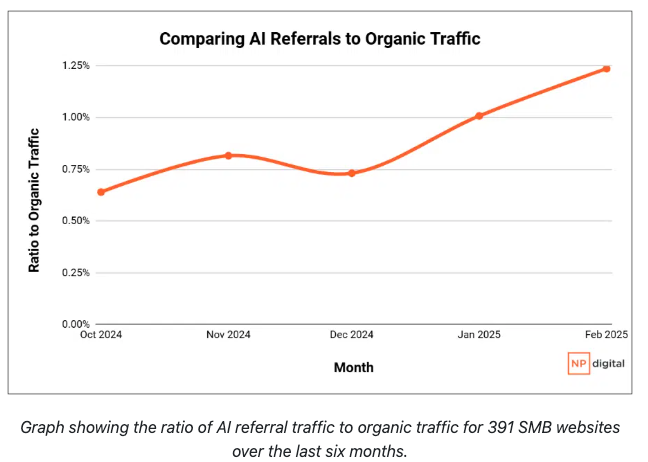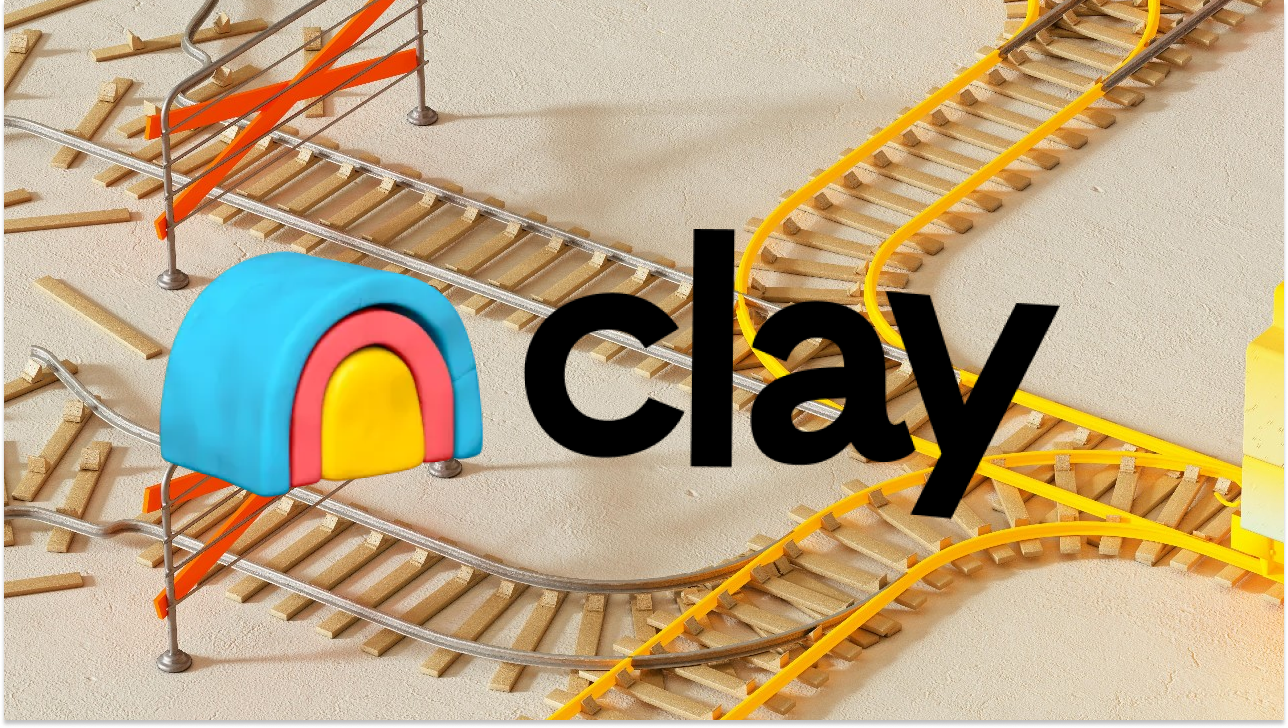TL;DR
The highest-converting visitors to B2B websites have never actually visited them. They learned everything from AI assistants, skip educational content entirely, and land directly on pricing pages ready to buy. While this AI-referred traffic represents less than 1% of total visits today, it converts at 23x the rate of organic search and is growing 12x year over year. The uncomfortable truth: your website isn't dying, it's becoming invisible infrastructure that powers AI recommendations without customers ever seeing it.
AI traffic represents less than 1% of total visits but converts 23 times higher than organic search, and it's growing exponentially.
Here's what should keep you up at night: Adobe tracked a 12x surge in AI-driven referral traffic between July 2024 and February 2025 and these visitors behave completely differently: they skip educational content, land directly on pricing pages, and convert at rates that defy logic.
B2B companies are discovering an uncomfortable truth: their highest-converting visitors have "never" been to their website before. They learned everything they needed from ChatGPT.
The decision facing every founder: optimize for the 99% of traditional traffic that barely converts, or rebuild for the 1% that could sustain your entire business once it scales.
Your marketing site is becoming a machine's reference manual.
So companies made a radical decision: stop writing for humans who would never visit, start structuring content for AI consumption.
The pattern isn't new. Instagram overtook beauty brand websites in 2019. Glossier's website traffic plummeted while sales exploded. Why? Customers discovered products through Instagram Stories, researched through influencer posts, then arrived knowing exactly which Cloud Paint shade they wanted. The website became merely a checkout mechanism.
AI accelerates this pattern across every industry simultaneously. OpenAI's September 2025 launch of Instant Checkout means 700 million weekly ChatGPT users can now buy from over one million Shopify merchants without ever "seeing" those merchants' websites.
The shift in behavior is stark: ChatGPT users ask 23-word questions instead of Google's 3.4 word searches. These visitors skip educational content entirely. They've already done their research within ChatGPT. By the time they land on pricing pages, they're pre-qualified from comparing alternatives, converting at much higher rates than traditional search.
Companies that acted early in 2024 by implementing comprehensive schema, restructuring content for AI comprehension, and building topic authority, are now seeing 3-25x conversion jumps from AI channels. Their blog posts appear in ChatGPT responses while traditional traffic declines. The upside: conversions from AI citations far exceed the volume loss. Fewer visitors, but far better customers.
This creates an uncomfortable question: if AI systems become the primary content consumers, what happens to the open web we've spent 30 years building?
The timeline is faster than your board thinks.
NP Digital's analysis of 391 SMB websites revealed the speed most boards aren't seeing: Between September 2024 and February 2025, referral traffic from generative AI rose by 123%.

Six months ago, AI referral traffic amounted to 0.54% of organic traffic. Today, that ratio is 1.24% - meaning the share of AI traffic to organic traffic has increased by 130% in just six months.
ChatGPT has been incrementally adding an average of 21% more traffic each month. At this rate, AI traffic could overtake social media referrals within 18 months.
The acceleration matches historical platform shifts. Netflix took 10 years to reach 100 million users. Instagram took 2 years. ChatGPT did it in 2 months.

But here's what boards miss: AI systems are learning their preferences right now. Every query teaches these platforms which sources to trust, which brands to recommend, and which companies deserve citations. The brands appearing in today's AI responses at 1% traffic share are cementing their position for when that share hits 10% or 20%.
The window to become AI's default recommendation is measured in quarters, not years.
Companies that act now can secure their permanent spot in AI recommendation algorithms. Those waiting for "more data" will find that competitors have already staked their claim.
The strategy isn't to abandon your website but to accept its new job.
Smart founders aren't choosing between optimizing their websites for humans or for AI. They're doing both.
The practical path requires parallel development. Keep your traditional web presence profitable while building for AI consumption.
Start tracking where you appear in AI responses. When ChatGPT answers questions about your category, do you get mentioned? Run this simple math: if your current AI traffic (converting at 23x) grew from 0.5% to 10% of total visits, what would revenue look like?
The companies acting now understand the shift:
"Websites aren't dying, they're becoming invisible infrastructure."
Just as AWS powers half the internet without users knowing it exists, your website will power AI recommendations without customers ever visiting.
The winners will be the ones who accept this new role while their competitors are still checking bounce rates.
Frequently asked questions
Q: Our AI traffic is currently 0.1% of total visits. Should we really restructure our entire web strategy for such a tiny segment?
Start with parallel tracks. Keep your current strategy running while you implement schema markup and structured data. The 12x annual growth rate means that 0.1% becomes 1.2% next year. At 23x conversion rates, that 1.2% could drive 20%+ of your revenue. The math says move now, but don't abandon what's working.
Q: How do we actually track if we're being cited in ChatGPT or Claude responses?
Run weekly manual checks: ask ChatGPT, Claude, and Perplexity about your product category and note if you appear. Use tracking tools for automated monitoring. Track "share of voice" in AI responses the same way you'd track SERP rankings. Set up Google Analytics to isolate AI referral sources (they show as "chatgpt.com" or "claude.ai" in your referral traffic).
Q: We're a new startup with no domain authority. Are we already too late?
You're actually in a unique position. While established players optimize their legacy sites, you can build AI-first from day one. Focus on becoming the most comprehensive, well-structured source on one specific topic. Databricks wasn't the biggest name but dominated "data lakehouse" queries by being the clearest, most structured source. Pick your niche and own it completely.
Q: What's the one technical thing we should implement tomorrow?
Organization schema markup using JSON-LD format. It helps AI systems understand who you are, what you do, and why you're credible. After that: FAQ schema for your most common customer questions. These map directly to how people query AI systems.
Q: How do we write content that works for both humans and AI?
Stop writing differently for each. AI systems reward the same things humans do: clarity, specificity, and expertise. The difference is structure. Put your key point in the first sentence of each section. Include specific numbers and outcomes.
Q: Should we stop investing in traditional SEO?
Not necessarily. Prioritize where your customers are. Are they searching you or your alternatives on AI search engines?
Q: What if AI platforms start charging for citations or visibility, like Google Ads?
They will. Perplexity already launched advertising products. But organic citations will remain valuable, just like organic search survived Google Ads. The difference: there's no "page 2" in AI responses. You're either cited or you're invisible. That's why moving now, while it's still merit-based, is critical.
References
[1] Superprompt (2025). "AI Search Traffic Converts 5x Better Than Google: 2025 Conversion Data from 12M Visits"
[2] Ahrefs/EngageCoders (2025). "Does AI Search Traffic Convert Better Than Traditional Search?"
[3] Seer Interactive (2025). "Case Study: 6 Learnings About How Traffic from ChatGPT Converts"
[4] UseHall (2025). "Conversions from ChatGPT & AI Search"
[5] Semrush (2025). "29 Eye-Opening Google Search Statistics for 2025"
[6] Adobe (2025). "The Explosive Rise of Generative AI Referral Traffic"
[7] Search Engine Land/NP Digital (2025). "SMB Websites See Rising Traffic from ChatGPT and Other AI Engines"
[8] Go Fish Digital (2025). "Generative Engine Optimization (GEO) Case Study: 3X'ing Leads"
.jpg)


